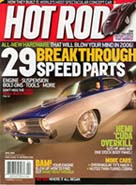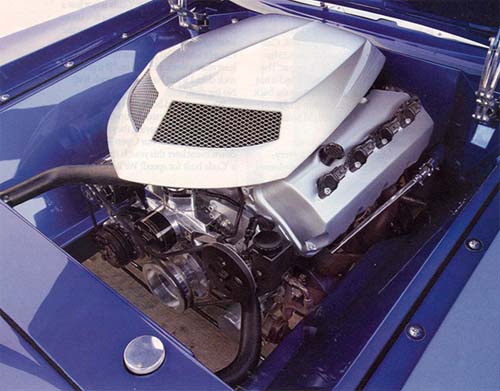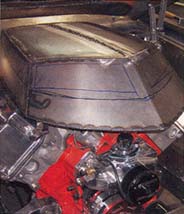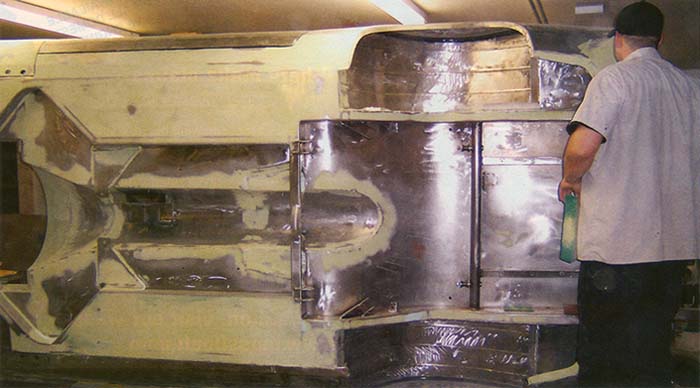

By: Rob Kinnan
Reprint from Hot Rod Magazine, April 2006
Photography: Wes Allison
Ted Hellard Spent Concours-Type Money to Build the Heavily Modified Hemi ‘Cuda of His Dreams, and He Did It Without Cutting Up a Real one.

> Hellard’s ‘Cuda was finished mere hours before it rolled into the SEMA show, and we shot it mere minutes after it came off the show floor, so it wasn’t a complete runner when we shot this feature. We expect it to be this summer, and we’ll put it to the test.
 ost of us watch the goings-on at a musclecar auction with equal parts wonder (“how much did that car just sell for?”) and disgust (“how much did that car just sell for?”). The wonder, of course, comes from seeing an original musclecar going for more than the typical single-family home, and the disgust comes from our inability to afford the car, and the realization that at this rate, we probably never will. But some hot rodders have more means than others and therefore have a far different set of boundaries.
ost of us watch the goings-on at a musclecar auction with equal parts wonder (“how much did that car just sell for?”) and disgust (“how much did that car just sell for?”). The wonder, of course, comes from seeing an original musclecar going for more than the typical single-family home, and the disgust comes from our inability to afford the car, and the realization that at this rate, we probably never will. But some hot rodders have more means than others and therefore have a far different set of boundaries.
Ted Hellard wanted a Hemi ‘Cuda and has a thick enough wallet to buy a real one, but being the hot rodder he is, he didn’t want a chalk-mark restoration. He wanted one built the way he wanted it, with some custom tricks here and there, and one that he wouldn’t be afraid to drive hard. Ted bought a ’66 Malibu convertible at a Barrett-Jackson auction and began talking with the car’s builder, Kevin Bradley of Kreations Auto Body (Rio Dell, California, 707/761-3525). As he and Kevin talked, they watched a few Hemi Mopars get the gavel for between $300,000 and a couple million each, and right then they hatched a plan to build one for themselves.

> A couple things are noticeable here. Note how the rockers are tapered so they’re shorter in the front. Also notice the rear valance, which was extended under the car and welded soild to the quarters.
“Ted wanted to put that kind of money into a clone that was built the way he wanted it and really shock the Mopar people, but with a car that they would still appreciate,” says Kevin. Starting with a very rusty ’70 ‘Cuda (which still cost $14,000), they spent 16 months and $340,000 to create the showstopper you see here. The car was finished a few hours before its debut at the ’05 SEMA show, where it decorated Budnik Wheels’ booth.
That $14,000 shell provided little more than the roof, quarters, and taillight panel. Everything else was replaced and heavily modified by Kreations. Let’s start at the nose of the car and work our way back. The grille was all handbuilt and uses aero tubing bars to resemble the original ‘Cuda grille. The front bumper was sectioned and tucked into the body. The bottom of the valance was extended 3½ inches to the underside of the car and has custom foglight notches. To make room for the 4 ½-inch engine setback, Kreations fabricated the stock cowl and firewall from scratch, and all the sheetmetal under the hood uses nothing from the stock ‘Cuda. The hood was handbuilt to fit the newly shaped front sheetmetal and custom Shaker hoodscoop.
Moving rearward, they fabricated the floor and transmission tunnel after setting the body over the chassis (more on that later). To give the car more rake, Kreations built rockers with wedge-cuts in the fronts and raised the bottoms of the front fenders to match, extending them all the way to the inner framerails as endless pans with no pinch welds—very smooth. At the rear, the wheelwells were opened up an inch to better showcase the big wheels. The rear valance was handbuilt and lengthened to reach farther under the car then welded in place. The taillights resemble
the stock ‘Cuda lights but are flush-mounted without a bezel. The roof also got the smooth treatment, losing the driprails and getting the edges rolled over into the window-seal area. The same was done to the A-pillars. The paint is Hot Hues from DuPont, in Jazzy Blue and Silva, sprayed by Kreations. After the car was cleared, it went to Mike LaValley at Killer Paint (Seattle, WA) for skeleton graphics within the hockey sticks, then it came back to Kreations nine days before the SEMA show to be re-cleared.
Remember when we mentioned that

Ted wanted to drive his car? That was the place from the outset, so Kevin called on Art Morrison to design a full chassis for the car that would allow some serious sideways antics. The front suspension uses 550-lb/in springs on Strange adjustable coilovers, with an Art Morrison 1-inch sway bar and an AGR rack-and-pinion steering setup. Strange coiovers with 300-lb/in springs are in the back and work with a Morrison triangulated four-link and 11/16-inch swaybar. The brakes are from Wilwood and operate with a manual master cylinder mounted under the custom dash at a 90-degree angle to the pedal. Finally, the one-off, 10-spoke wheels were custom cut on Budnik’s mill in 19×8 and 20×19 sizes and carry Toyo tires. Kevin says that rubber never touches metal, thanks to the custom sheetmetal fabrication.
Powering the beast is a stock Mopar Performance 528 crate Hemi topped with an Indy Cylinder Heads intake modified to carry 42-lb/hr fuel injectors and a 1,000-cfm MSD throttle-body. A F.A.S.T. computer fires those injectors (which are delivered gas via an Aeromotive A-1000 electric pump from a Kreations-built stainless steel tank), and works with an MSD crank trigger to fire Acura coils. Kreations built the 1-inch-primary headers that connect to Spin Tech 3-inch mufflers and dump through Spin Tech’s trick 3-inch oval tubing. On the dyno at Mopar Engines West (Morgan Hill, California), the

EFI Hemi cranked out 625 hp (at 6,200 rpm) and 650-ft of torque. The trans is a 727 automatic from TCI and it has a Gear Vendors overdrive tacked on the back to civilize the 4.11:1 gears within an Art Morrison-built housing with all Strange internals.
The interior is more of the same; Kreations fabricated pretty much everything, including the seat frames upholstered by McFarland Custom Upholstery in light taupe leather. The headliner is a one-piece molded fiberglass unit covered in leather, the all-steel dash was built by Ryan McNamarra at Kreations and stuffed with Auto Meter gauges, and Alpine tunes wired by Eureka Car Stereo.
We first saw the ‘Cuda at the SEMA Show, and had photographer We
Allison get these shots the minute it rolled out of the convention center, and the car was still unfinished. But as we write this, Kevin says it’s a running, driving car, and he and Ted are both adamant that their killer ‘Cuda is not just a show car. True, it will be hitting a few shows over the winter of 2005/2006, but once the weather turns nice it’ll head home to Canada where Ted plans on driving it at least once a week. He told us, “If if gets a rock chip, I’ll just have Kevin touch it up, No Big deal.”
We questioned both guys whether or not they were blowing smoke up our keister and they responded by saying they will have the car ready to rock at our Open Track Smackdown event later this year. Is this a poseur or a ‘Cuda built for speed? We’ll soon see.

> Above: The wheels are one-offs from Budnik. They’re tucked but supposedly don’t rub anywhere.
> Left: These before and after shots will give you an idea of the amount of custom metalwork that went into the front end.
“I don’t build cars to show,
I build them to drive.â€
—Ted Hellard



> Top: The ‘Cuda is now a two-seater. Auto Meter gauges sit in a custom dash in front of a Budnik wheel. Marvin Taylor of Fortuna, California, wired it.
> Left: The engine is an out-of-the-box 528 crate Hemi from Mopar Performance with the exception of a F.A.S.T fuel injection system. Mopar Engines West tuned it. Acura coils fit the spark-plug holes perfectly.
> Above: The Custom Shaker scoop is functional and also serves as an engine cover.

POWERTRAIN
Engine: A Mopar Performance 528 crate Hemi is as-delivered with the exception of the
induction system. It now has a F.A.S.T.-controlled EFI system on a modified Indy Cylinder Heads intake manifold. Kreations
Auto Body also built the headers, which were then coated by RS Performance Coatings in South San Francisco, California.
Power: Engines West turned the EFI on its dyno and coaxed 625 hp and 650 lb-ft out of
the Hemi.
Transmission: A TCI 727 TorqueFlite with a tight 11-inch 2,000-stall converter is
mated to a Gear Vendors overdrive.
Rearend: Art Morrison built the axlehousing and stuffed it with all Strange innards,
including 4.11 gears, a limited slip, and 31-spline axles.
> Right and far right: The stock rear panel was retained
but heavily modified to flush the lights. A ¾-inch strip of metal was also welded to the top of the panel to fill the
space under the trunklid.
CHASSIS
Suspension: Originally a unibody design, the ‘Cuda now sits on a complete Art Morrison
chassis with Strange coilovers and a rack-and-pinion. The rear is designed around a triangulated four-link suspension.
Brakes: Wilwood 14-inch (front) and 13-inch (rear) two-piece rotors get grabbed by
six-piston calipers. The rotor hats were chromed.
Wheels: The wheels are custom designs from Budnik built to Kreations’ specs. The fronts
are 19×8 with 5¾ inches of backspacing and the rears are 20×10 with 4½ inches of backspacing.
Tires: The tires are from Toyo, with 315/35-20s in back and smallish 225/35-19s in
front.

STYLE
Body: There are far more fabricated panels than stock sheetmetal pieces on this car, so
rest assured that if you can see it, it’s been modified.
Interior: Kreations’ Ryan McNamarra built the custom steel dash and then coated it with
Hot Hues Hot Matte Clear to give it a satin look. The leather work was performed by McFarland Custom Upholstery, and the custom
floating trans-
tunnel piece was built by Kreations and airbrushed by Killer Paint to carry the bone theme to the inside of the
car. There’s also a Vintage Air Supercooler and three-point belts.
Paint: Kreations sprayed the DuPont Hot Hues in Jazzy Blue and Silva, separated by an
1/8-inch light-blue divider striped that coated in lots of clear. The graphics were done by Killer Paint in Seattle.


> Note how the body panels were extended under the car and welded solid to the Art Morrison frame.